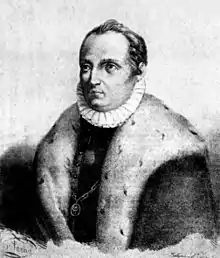Antonio Musa Brassavola
Antonio Musa Brassavola (variously spelled Brasavoli, Brasavola, or Brasavoli;[1] 16 January 1500 – 1555) was an Italian physician and one of the most famous of his time. He studied under Niccolò Leoniceno and Giovanni Manardo. He was the friend and physician of Ercole II, the duke of Este. He was also the consulting physician of Kings Francis I, Charles V, Henry VIII and Popes Paul III, Leo X, Clement VIII and Julius III. He performed the first successful tracheotomy,[2] and published an account of it in 1546. He was the chair of philosophy in Ferrara and also studied botany and medicine.[1] A genus of orchid, called Brassavola, is named after him.[3]
Antonio Musa Brassavola | |
|---|---|
 | |
| Born | 16 January 1500 |
| Died | 6 July 1555 Ferrara |
| Nationality | Italian |
| Alma mater | University of Ferrara |
| Scientific career | |
| Fields | anatomy medicine botany |
| Institutions | Ferrara |
| Doctoral advisor | Niccolò Leoniceno Giovanni Manardo |
| Doctoral students | Gabriele Falloppio |
Writings (selection)
- Examen omnium simplicium medicamentorum, quorum in officinis usus est. Jean & François Frellon, Lyon, 1537
- Examen omnium syruporum, 1540 Digital edition by the University and State Library Düsseldorf
- In octo libros aphorismorum Hippocratis & Galeni commentaria & annotationes, 1541
- In libros de ratione victus in morbis acutis Hippocratis & Galeni commentaria & annotationes, 1546
- Examen omnium electuariorum. Venice, ex Officina Erasmiana Vincentii Valgrisii, 1548 Digital edition by the University and State Library Düsseldorf
- Index refertissimus in omnes Galeni libros, 1556
His writings consist of works in the fields of medicine and botany. He also wrote extensively about the physician Galen.
References
- Fielding Hudson Garrison (1913). An Introduction to the history of medicine, with medical chronology, bibliographic data and test questions. W.B. Saunders Co. pp. 163–. Retrieved 22 February 2012.
- A Brief History of the Tracheotomy. American Academy of Otolaryngology
- Ingrid Schmidt-Ostrander Orchid's Names another Little Essay. The Journal of the Canadian Orchid Congress. Volume 16.4 September 2004